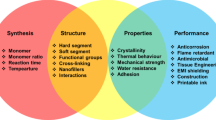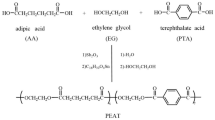Abstract
This article reported a novel type of lipophilic polyelectrolyte resin with high oil absorbency and mechanical properties, which was suitable to use, store, and recycle. A certain amount of weakly coordinating ions was introduced in a suitable network structure of copolymer resin of styrene/butyl methacrylate/stearyl methacrylate by chloromethylation reaction, quaternization reaction, and anion exchange reaction. The structure and particle morphology of resin were characterized by Fourier transform infrared spectrometry and scanning electron microscopy, respectively. Research on oil absorption test has revealed that lipophilic polyelectrolyte resin had higher oil absorbency, faster oil-adsorbing rate, and better reusability compared with non-ionic oil absorption resin. Meanwhile, the effect of the content of ionic groups on the oil absorbency of the lipophilic polyelectrolyte resin was also investigated. The results showed that the maximum of oil absorbency of the resin to the carbon tetrachloride was 37.86 g/g when the content of ionic groups was 4.54 wt%.







Similar content being viewed by others
References
Ibrahim S, Wang SB, Ang HM (2010) Removal of emulsified oil from oily wastewater using agricultural waste barley straw. Biochem Eng J 49:78–83
Maiti S, Mishra IM, Bhattacharya SD (2010) Removal of oil from oil-in-water emulsion using a packed bed of commercial resin. Colloids Surf A 389:291–298
Wu B, Zhou MH (2009) Recycling of waste tyre rubber into oil absorbent. Waste Manag 29:355–359
Ji NY, Chen H, Yu MM, Qu RJ, Wang CH (2011) Synthesis of high oil-absorption resins of poly(methyl methacrylate-butyl methacrylate) by suspended emulsion polymerization. Polym Adv Technol 22:1898–1904
Lou S, Liu YF, Di DL (2012) Synthesis of functional adsorption resin and its adsorption properties in purification of flavonoids from Hippophae rhamnoides L. leaves. Ind Eng Chem Res 51:2682–2696
Shan GR, Xu PY, Weng ZX (2003) Oil-absorption function of physical crosslinking in the high-oil-absorption resins. J Appl Polym Sci 90:3945–3950
Zhang JP, Seeger S (2011) Polyester materials with superwetting silicone nanofilaments for oil/water separation and selective oil absorption. Adv Funct Mater 21:4699–4704
Shimizu T, Koshiro S, Yamada Y (1997) Effect of cell structure on oil absorption of highly oil absorptive polyurethane foam for on-site use. J Appl Polym Sci 65:179–186
Miller JM, Dahan A, Amidon GL (2010) Enabling the intestinal absorption of highly polar antiviral agents: ion-pair facilitated membrane permeation of zanamivir heptyl ester and guanidino oseltamivir. Mol Pharmacol 7:1223–1234
Imran AB, Seki T, Ito K, Takeoka Y (2010) Poly(N-isopropylacrylamide) gel prepared using a hydrophilic polyrotaxane-based movable cross-linker. Macromol 43:1975–1980
Yuan JY, Antonietti M (2011) Poly(ionic liquid)s: polymers expanding classical property profiles. Polym 52:1469–1482
Suarez IJ, Martin BS, Barbero AF (2009) Swelling of ionic and non-ionic minigels. Colloids Surf A 343:30–33
Valade D, Boschet F, Ameduri B (2009) Synthesis and modification of alternating copolymers based on vinyl ethers, chlorotrifluoroethylene, and hexafluoropropylene. Macromol 42:7689–7700
Tang HD, Tang JB, Shen YQ, Radosz M (2005) Atom transfer radical polymerization of styrenic ionic liquid monomers and carbon dioxide absorption of the polymerized ionic liquids. J Polym Sci Part A: Polym Chem 43:1432–1443
Ono T, Sugimoto T, Shinkai S, Sada K (2007) Lipophilic polyelectrolyte gels as super-absorbent polymers for nonpolar organic solvents. Nat Mater 6:429–433
Ohta M, Ono T, Sada K (2011) Layer-by-layer deposition of ionomers with lipophilic ion-pairs dissociated in less-polar media. Chem Lett 40:648–650
Hamamoto H, Kudoh M, Takahashi H, Ikegami S (2006) Novel use of cross-linked poly(N-isopropylacrylamide) gel for organic reactions in aqueous media. Org Lett 8:4015–4018
Ono T, Sugimoto T, Shinkai S (2008) Molecular design of superabsorbent polymers for organic solvents by crosslinked lipophilic polyelectrolytes. Adv Funct Mater 18:3936–3940
Zhou YB, Tang XY (2010) Effect of quaternary ammonium surfactant modification on oil removal capability of polystyrene resin. Sep Purif Technol 75:266–272
Fang P, Mao PP, Chen J, Du Y, Hou X (2014) Synthesis and properties of a ternary polyacrylate copolymer resin for the absorption of oil spills. J Appl Polym Sci. doi:10.1002/app.40180
Lu CL, Gao BJ, Liu Q (2008) Preparation of two kinds of chloromethylated polystyrene particle using 1,4-bis (chloromethoxy) butane as chloromethylation reagent. Colloid Polym Sci 286:553–561
Dauschmidt JP, Mayr H (1994) Relative reactivities of alkyl chlorides under Friedel-Crafts conditions. Chemische Berichte 127:205–212
Haouet MN, Altissimi MS, Framboas M, Galarini R (2006) Validation of the Volhard method for chloride determination in food. Accred Qual Assur 11:23–28
Veverka P, Jerabek K (1999) Mechanism of hypercrosslinking of chloromethylated styrene-divinylbenzene copolymers. React Funct Polym 41:21–25
Teixeira VG, Coutinho F (2010) Morphological study on the reactivity of styrene-divinylbenzene copolymers in a chloromethylation reaction. J Appl Polym Sci 118:2389–2396
Iseda K, Ohta M, Ono T, Sada K (2011) High swelling ability of polystyrene-based polyelectrolyte gels at low temperature. Soft Matter 7:5938–5940
Acknowledgments
This work was financially supported by the Natural Science Foundation of China (Grant No. 21172167) and Science and Technology Foundation of Tianjin (Grant No. 14JCTPJC00505)
Author information
Authors and Affiliations
Corresponding author
Electronic supplementary material
ESM 1
(DOCX 410 kb)
Rights and permissions
About this article
Cite this article
Chen, J., Fang, P., Du, Y. et al. Synthesis and properties of lipophilic polyelectrolyte styrene/butyl methacrylate/stearyl methacrylate resin as absorbent materials for organic solvents and oils. Colloid Polym Sci 294, 119–125 (2016). https://doi.org/10.1007/s00396-015-3762-x
Received:
Revised:
Accepted:
Published:
Issue Date:
DOI: https://doi.org/10.1007/s00396-015-3762-x




